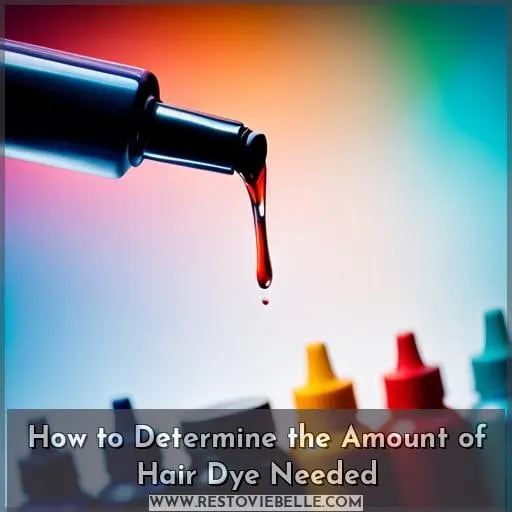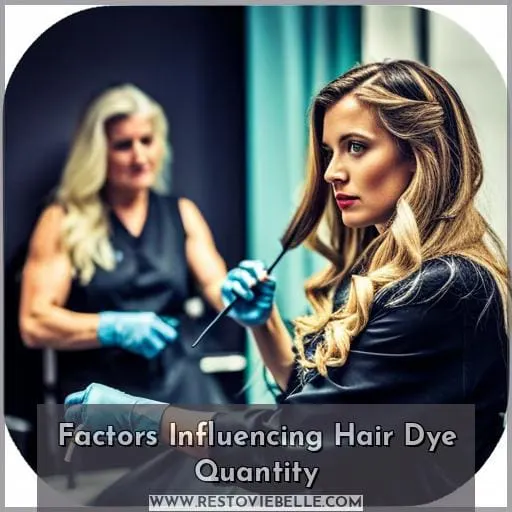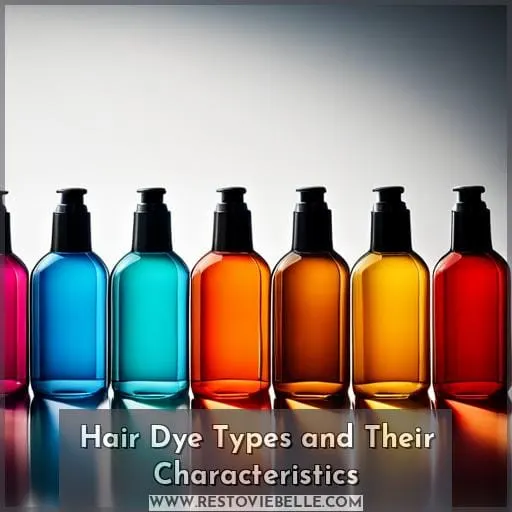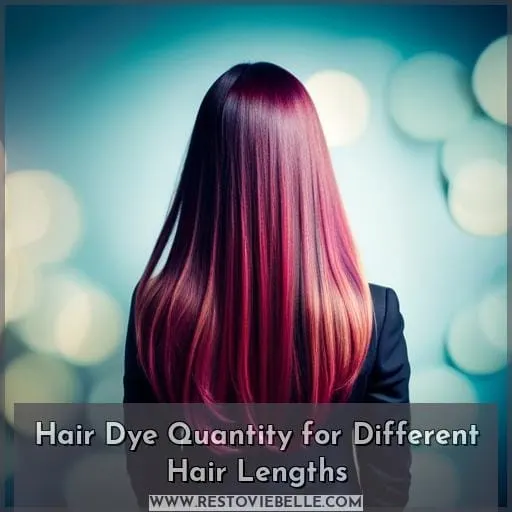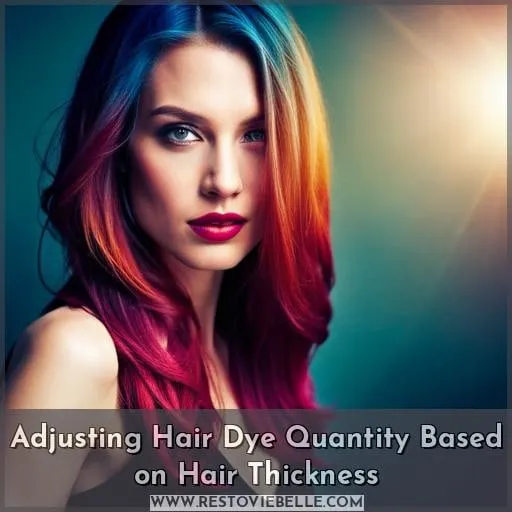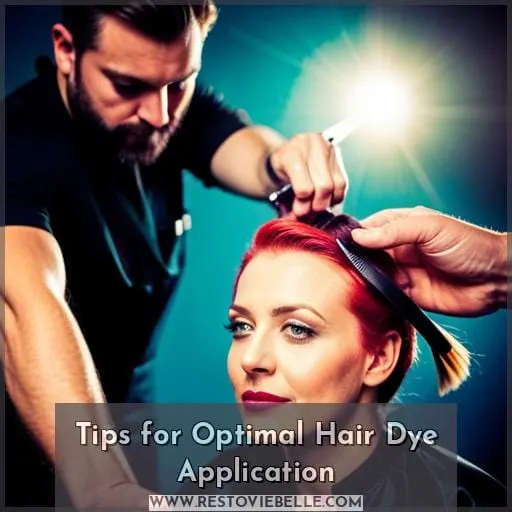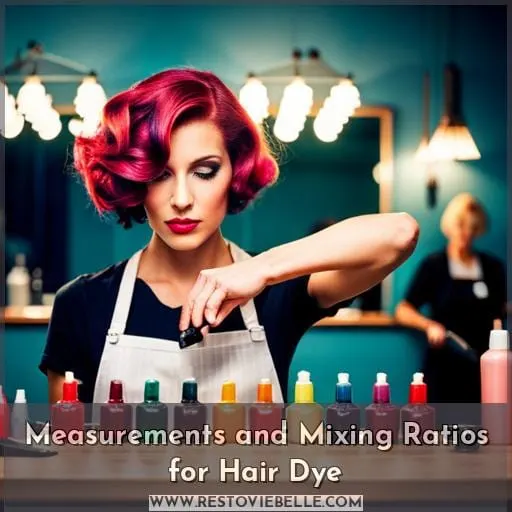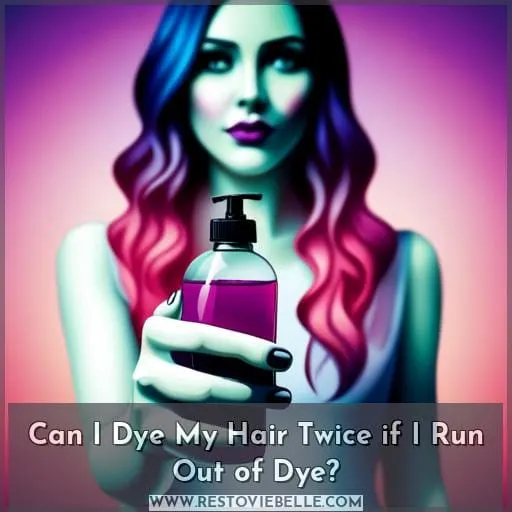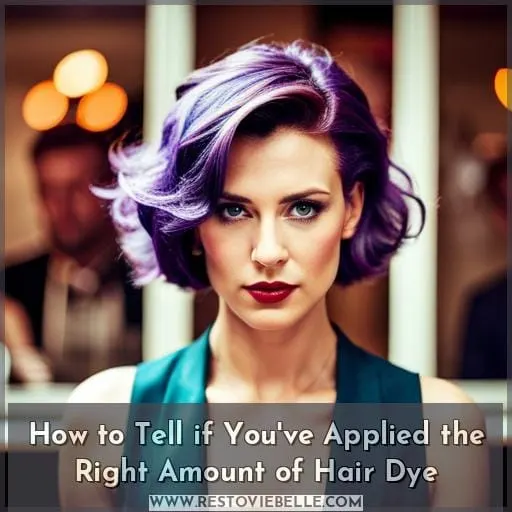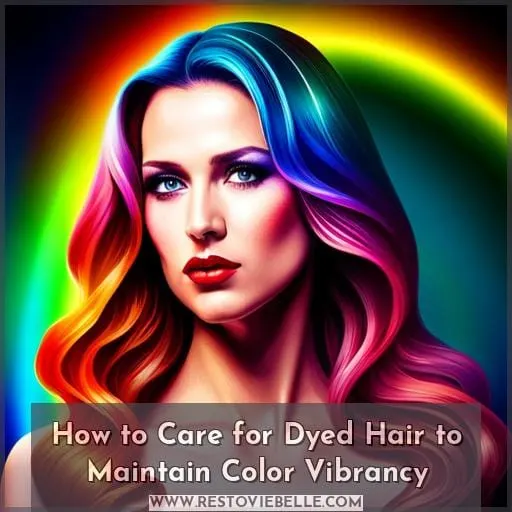This site is supported by our readers. We may earn a commission, at no cost to you, if you purchase through links.
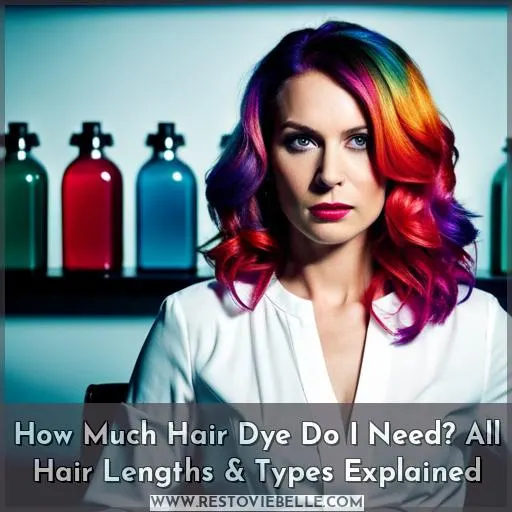 Confused about how much hair dye you need to color your tresses? You’re not alone.
Confused about how much hair dye you need to color your tresses? You’re not alone.
To help answer this age-old question – “How much hair dye do I need?” – let’s take a look at some factors which may influence how many ounces of dye are necessary for optimal results. Hair length, texture and type, desired intensity of color as well as graying coverage are important considerations when trying to determine the right amount.
Additionally, different types of dyes have varying characteristics with permanent being more concentrated than temporary while natural having fewer chemicals but requiring more product for full coverage.
Knowing these details can go a long way towards saving yourself time and money!
Table Of Contents
- Key Takeaways
- How to Determine the Amount of Hair Dye Needed
- Factors Influencing Hair Dye Quantity
- Hair Dye Types and Their Characteristics
- Hair Dye Quantity for Different Hair Lengths
- Adjusting Hair Dye Quantity Based on Hair Thickness
- Tips for Optimal Hair Dye Application
- Measurements and Mixing Ratios for Hair Dye
- Can I Dye My Hair Twice if I Run Out of Dye?
- How to Tell if You’ve Applied the Right Amount of Hair Dye
- How to Care for Dyed Hair to Maintain Color Vibrancy
- Frequently Asked Questions (FAQs)
- Conclusion
Key Takeaways
- Hair length, texture, and desired color intensity influence the quantity of hair dye needed.
- Different types of hair dyes, such as permanent, natural, and semi-permanent, have varying coverage and longevity.
- Hair type, such as thin or thick, and gray hair coverage requirements also affect the amount of hair dye needed.
- It is important to properly mix and apply the hair dye, and consider post-dye care and safety precautions for optimal results.
How to Determine the Amount of Hair Dye Needed
Discover how to determine the perfect amount of hair dye for your unique locks so you can get the look you desire without wasting product.
First, consider your hair length and thickness when estimating ounces of dye needed. Shorter styles require 1 box (4oz-4.7oz), shoulder-length styles require 3 boxes (9.
If you’re doing a root touch up, one box will do. However, for even coverage throughout sections with longer lengths, opt for two boxes instead.
It’s also important to factor in desired color intensity and type of dye. Vibrant hues call for more than subtler shades. Permanent dyes typically last longest but contain ammonia, which can be damaging over time.
Natural options like henna or herbal extracts offer gentle results with minimal risk involved. Semi-permanent dyes last 4-12 washes without peroxide or ammonia present either.
Lastly, read through manufacturer instructions carefully before starting out. Then, invest in quality products specifically meant to protect colored strands against fading and damage from daily styling routines!
Factors Influencing Hair Dye Quantity
Determining the correct amount of hair dye for your specific needs depends on several factors. These factors include hair length, thickness, desired color intensity, texture and type, as well as gray hair coverage.
Having knowledge of these details can help guarantee that you achieve vibrant results with the perfect amount of product each time.
Hair Length
Your hair length plays a key role in determining how much dye you’ll require for the perfect look. For short hair, one box (4oz-4.7oz) of dye is enough; medium-length needs 1-2 boxes, while waist or longer may need 2 boxes.
Root touch-ups and color intensity also affect how much product to use, as does texture – thin and curly often need extra for even coverage. Investing in color-protective products will help maintain dyed locks when done right with the proper quantity of dye! Long Hair, Short Hair, Medium-Length Hair, Dyeing Long Hair.
Hair Thickness
Thick hair requires more dye than thin hair to achieve an even, vibrant color. Hair strand width affects the absorption rate of hair color and can dictate how many boxes of dye you need for coverage. To ensure gray coverage or intense colors on thick locks, it is important to consider two factors: box dye quantity and natural dyes used in combination with chemical products.
For short lengths, one box should suffice. Medium-length hair may require 1-2 boxes, while long lengths might demand up to 2 boxes.
Natural henna or herbal extracts are great alternatives that will not damage strands as much but result in a subtle hue change.
Desired Color Intensity
Vibrant hues require more paint on your palette for optimal results, like adding extra layers of color to a masterpiece. Intensifying color with box dye or cream developer is essential for long-lasting vibrancy, and root touchups may need an additional box.
Natural hair dyes tend to be less intense than temporary dye but can still deliver vivid tints.
To ensure the desired level of intensity that complements natural locks and stands out in the crowd, invest in reputable products supported by helpful tutorials online. Color-protecting items are also necessary to preserve your shade’s luster over time without fading or dulling prematurely.
Hair Texture and Type
Your hair’s texture and type will affect how much dye you require for optimal results. Permanent, demi-permanent, semi-permanent, temporary, and natural dyes can all vary in the amount needed to achieve your desired intensity of color.
Generally speaking, thin hair requires less dye than thick or curly hair, while gray coverage may need extra product and longer application time. Boxed dyes are metered with an activator ratio – 2oz of color cream for every 2oz activator (total 4oz).
If you have long or waist-length locks, then two boxes might be necessary to cover evenly, whereas short tresses usually only need one box (4 oz).
Adjust quantities as per your individual needs. Investing in quality products designed specifically for protecting dyed hair is key!
Gray Hair Coverage
For gray coverage, amplify your hue with extra dye to avoid dullness. Gray hair requires more dye than other colors for a vibrant finish and longer-lasting results. When choosing your color, consider the level of ammonia exposure to protect delicate strands from chemical damage while still achieving desired results.
Ensure even distribution and adherence by buying enough product for full coverage—up to two boxes depending on length and thickness—and carefully follow instructions provided with each brand’s products.
For optimal longevity, use color-protecting shampoos and conditioners that retain vibrancy without sacrificing health or shine.
Hair Dye Types and Their Characteristics
Deciding on the right hair dye for your needs is not an easy task. Permanent, semi-permanent, temporary, and natural dyes all provide unique benefits depending on what you’re looking for. Permanent dyes last longer but can be damaging to your hair due to chemical ingredients, whereas semi-permanent dyes are gentler and may only last 4-12 washes.
Temporary dye is washable, making it ideal for short-term changes, while a natural alternative like henna or herbal extracts offers subtle results without harsh chemicals.
Permanent Hair Dye
Permanent hair dye offers long-lasting results, but it can also be harsh on your locks if you’re not careful. It’s a great choice for highlighting and color correction. However, bleaching may be necessary first to get even coverage.
When using permanent dye, the perfect amount of product is key. Using too little or too much will lead to yellow tones and patchy roots, respectively. Invest in an ammonia-free formulation for root touch-ups or all-over color application.
Semi-Permanent Hair Dye
Semi-permanent dye offers a gentler alternative to permanent color, lasting for several washes without the use of harsh chemicals. It’s ideal for those who want temporary changes in color or just need occasional root touch-ups.
This type of hair dye requires less product than permanent and usually comes with 2oz of color cream and an activator totaling 4oz per box. For regular application, one box can cover shoulder-length hair, but it’s recommended to have extra on hand in case more is needed due to miscalculation or the requirement of a twice-dyeing process.
Additionally, using quality products like conditioners that protect dyed hair from fading is essential when applying semi-permanent dyes.
Temporary Hair Dye
For a temporary change of look, try using a washable hair dye to achieve subtle but vibrant results. Washable dyes are ideal for short-term color changes and can be easily washed out when desired. When selecting dye quantity, consider the length and thickness of your hair as well as root touch-ups; thinner or shorter hairs need less than thicker or longer ones.
For best results, follow instructions carefully and invest in color-protecting products for maintenance tips like preventing fading or removing excess dye.
Natural Hair Dye
Natural dye offers a gentle way to color your hair without harsh chemicals, allowing you to explore vibrant tones and subtle hues that flatter your unique look. Using natural dyes like henna or herbal extracts provides an ammonia-free and peroxide-free alternative for coloring hair.
It is important to consider the length and thickness of your hair when calculating the amount of dye needed for optimal application results. When using natural dyes, allow extra time to estimate how much product will be used, as some techniques may require multiple applications due to their temporary nature.
Dyeing with plant matter gives you control over what goes on in this process while also providing achievable colors, which can help create a stunning new hairstyle! Investing time into properly estimating natural dye quantity based on individual characteristics such as length and texture helps ensure successful results every time!
Hair Dye Quantity for Different Hair Lengths
Choosing the right amount of hair dye is key for achieving a vibrant, long-lasting result. Depending on your hair length, you’ll need to adjust the quantity accordingly: short locks may require just 1 box (4 oz-4.
Short Hair
For short hair, you’ll require a surprisingly small amount of dye to get the vibrant and long-lasting color you desire. To ensure even coverage and desired results, consider root touch-ups or carefully mix your own ammonia levels with hair dye kits.
When it comes to mixing dyes, use the right ratio for color saturation and protect treated locks by investing in quality products specifically designed for colored tresses.
Color protection is key when it comes to keeping your shade looking fresh! With these tips in mind, feel free to experiment with different techniques like balayage or ombre effects as well as boosting shine on already-colored locks – all while avoiding unnecessary damage from overloading strands with chemicals that can strip away luster from color-treated hair care.
Medium-Length Hair
For medium-length hair, you’ll likely need 1-2 boxes of dye to achieve the desired look. Hair texture and color process should be taken into consideration when selecting a brand, as well as having an extra box on hand just in case.
The correct mixture is crucial for a balanced application, so it’s important to carefully follow the instructions for optimal results. By following dyeing tips such as using enough product and evenly covering all strands, you can achieve vibrant coverage without causing damage to your locks.
Long Hair
Long hair typically requires two boxes of dye for even, vibrant coverage – so don’t skimp on the supplies! When dyeing long hair, it’s important to achieve consistent and thorough coverage. The optimal amount is usually 2 boxes (9.4oz) of natural or permanent dye in order to get the desired color intensity from root touch-ups to full head application.
Each box includes a 2oz tube of color cream and an activator that must be mixed together before applying the hair dye for best results.
With proper preparation and care, you can enjoy beautiful dyed tresses with incredible shine without compromising on health or style goals!
Waist-Length Hair
You may find that waist-length hair requires two boxes of dye for even coverage and a vibrant result. Before you begin, consider the type of color process and brand preference to ensure optimal results.
To achieve an even application with minimal damage, gently tug small sections as you mix your dye in a 1:1 ratio. This will help saturate each strand evenly without overdoing it on any one area.
For extra protection against fading or brittleness, opt for color-protecting products like shampoos and conditioners after dying.
With proper care at home (and maybe the occasional root touch up), you’ll be able to enjoy beautiful locks at their fullest potential!
Adjusting Hair Dye Quantity Based on Hair Thickness
Determining the correct amount of hair dye for your specific needs can be challenging. Depending on how thick your hair is, you may need to adjust the quantity accordingly – thin hair generally requires less dye than thicker or curly variants.
Thin Hair
Thin hair usually requires less dye than other types, so don’t be afraid to take a chance and go for that bold look – nothing ventured, nothing gained!
When choosing the right hair dye for thin strands, consider your desired color intensity as well as the type of dye. Natural dyes are gentler on delicate textures, while permanent options offer longer-lasting results.
For best results, apply evenly by following instructions carefully and investing in quality products designed specifically for thin or damaged hair.
Thick Hair
Thick hair requires more dye to achieve even coverage and vibrant color. When it comes to different types of hair dye, thick hair will require extra amounts for optimal results.
From root touch-ups to achieving an intense color intensity, having the right amount helps achieve quality coverage and saturation. Taking proper care of your dyed thick hair is key in maintaining a healthy appearance over time.
Make sure you purchase enough boxes so you don’t run out when trying new shades. This way, you can experiment without compromising on great results!
Curly Hair
Curly hair tends to require extra dye due to its unique texture, so consider adding an additional box for uniform coverage. To avoid damaging the hair with ammonia and other chemicals, opt for a semi-permanent or natural dye that won’t cause too much harm.
Monitor the consistency of the dye while applying it in order to get even results without overusing product. Investing in color protecting products is essential after coloring as this will help keep your tresses looking vibrant for longer periods of time and minimize any consequences from using permanent dyes such as split ends or dryness.
Additionally, toners can be used if you’d like further adjustments after coloring; however, make sure you apply them properly as incorrect application may lead to more damaged strands!
Tips for Optimal Hair Dye Application
To achieve the most vibrant and long-lasting hair color, it’s essential to carefully follow dye instructions, purchase extra boxes of dye for unexpected needs, intensify color with protective products as necessary, and accept excess dye results.
Invest in quality color-protecting products post-dyeing to maintain your desired look – this will ensure optimal results without damaging your hair.
Following Instructions
Follow instructions closely for best results and save yourself time by avoiding unnecessary dye applications. Pay attention to the details of mixing cream and developer, toning after dyeing hair, or applying extra dye.
Knowing the right quantity is essential for an effective hair-dyeing session; one box can be enough for root touch-ups or short hair, but longer locks might require two boxes. Consider your desired color intensity when deciding how much to buy – vibrant hues may need more than subtler ones.
Purchasing Extra Dye
It’s always good to stock up and buy an extra box of dye, just in case you need it for even color saturation. When selecting a dye choice, consider the quantity of boxes based on hair length and thickness.
For intense colors or gray coverage, you may need more. Mixing the developer ratio correctly is also important for achieving desired results – too much can dry out hair, while not enough won’t provide full coverage.
Additionally, when toner is used to reduce brassiness after lightening hair, adjust the amount accordingly depending on how many shades lighter you want your locks to go! With all these factors taken into account, purchasing extra dye will ensure optimal results with minimal effort during the application process!
Intensifying Color and Longevity
For truly vibrant hair color that lasts, invest in products specifically designed to protect and nourish dyed locks. Color-correcting shampoos help maintain hue between touch-ups, while root-touching treatments are ideal for coverage of regrowth without the need to recolor entire lengths.
Ammonia-free formulas can be used before lightening, allowing scalp protection without sacrificing desired results. Different specific needs require different amounts of product. Consider coloring hair in sections for even application.
A thorough review afterwards will identify any missed areas that might have been left out during the initial dyeing process.
Excess Dye Acceptability
Excess dye can be beneficial to ensure even coverage and vibrant color, so don’t shy away from it! If you’re looking for intense results that last, consider permanent dyes, which involve higher levels of ammonia.
For gentler options with fewer chemicals, opt for semi-permanent or natural hair colors, such as henna or herbal extracts.
To avoid uneven patches when dyeing longer lengths of hair, always purchase an additional box than what’s recommended on the packaging.
Color-Protecting Products
Invest in color-protecting products to maintain the magnificence of your dyed mane.
- Color-protecting ingredients such as amino acids and antioxidants slow down fading.
- Dye-resistant hair treatments add a protective layer that preserves vibrancy while fighting humidity and UV rays.
- Protecting shampoos, conditioners, and masks nourish strands with provitamins B5 & E for enhanced color-locking power.
- Color-locking products like leave-in creams help lock in hue without weighing down tresses or making them greasy.
- To prevent premature fading, invest in quality toners or glosses with special pigments which will last up to 28 washes!
Pamper your hair regularly for maximum longevity of its luscious locks!
Measurements and Mixing Ratios for Hair Dye
Having vibrant, colored hair is an exciting experience. To achieve the best results when dyeing your hair, it’s important to consider the cream and developer ratio, the quantity of toner after dyeing, and how much dye comes in a box of store-bought color.
With these tips, you’ll be able to customize your perfect shade while avoiding any potential messes or mishaps.
Cream and Developer Ratio
You should always consider the cream and activator ratio when determining how much hair dye to purchase for optimal results. When selecting a permanent or semi-permanent dye, bear in mind that stronger dyes require more product due to higher ammonia levels.
For root touch ups, short hair usually needs one box of 4oz-4.7oz, while medium length requires 1-2 boxes (4.
Vibrant colors will also necessitate additional amounts for best coverage; don’t forget about natural options too! Mixing ratios are key when aiming for successful application, so be mindful of your selection before purchasing any products—your locks will thank you later!
Toner Quantity After Dyeing
After dyeing, determine the amount of toner needed to achieve your desired result. The choice of dye and toning techniques can vary depending on color intensity. Make sure to undergo allergy testing before using any product, as stain removal may require harsher treatments than usual hair care products.
When selecting a tone shade for your hair, consider whether it’s permanent or semi-permanent and how vibrant you want the end result to be.
To ensure longevity of dyed hair with minimal fading effects, invest in color protecting products that help maintain healthy locks without compromising vibrancy!
Amount of Dye in Box Dye
When selecting box dye, consider the amount of dye per box for optimal coverage. A standard box contains 4 oz: 2 oz color cream plus 2 oz activator. For short or root touch-up hair, one may suffice; medium to long lengths will require 1-2 boxes, while waist length might need two.
Hair texture and desired color intensity also come into play—thickness requires more, and vibrancy needs extra too! For even saturation, use additional product when needed but invest in protective products afterward for best results.
Can I Dye My Hair Twice if I Run Out of Dye?
If you run out of dye, it may be possible to dye your hair again depending on the color intensity required. It’s important to note that many professional stylists suggest not doing this more than twice, as repeated applications can damage the hair’s cuticle and cause breakage.
To ensure success with a second application, consider using henna or natural dyes for better maintenance without ammonia levels rising too high. Only bleach if absolutely necessary; otherwise, use demi-permanent colors instead.
Depending on your desired outcome, additional bleaching and lightening might be an option. However, keep in mind that these will further damage fragile strands already weakened by peroxide and coloring agents.
How to Tell if You’ve Applied the Right Amount of Hair Dye
To ensure optimal color results, use the right amount of hair dye based on your hair’s length, type, and desired intensity.
- For root touch-ups or short hair (1–2 oz), 1 box (4 oz-4.7 oz) usually suffices. For medium to long lengths (3–6 oz), you may need 1-2 boxes depending on thickness and texture.
- If aiming for a vibrant hue or gray coverage, more dye is necessary. Likewise, if using natural dyes such as henna or herbal extracts instead of chemical solutions like permanent dyes with ammonia/peroxide.
- Mixing an extra box when dyeing can be useful to avoid running out unexpectedly. Applying toner post-dye also helps boost vibrancy over time while maintaining your hue via regular maintenance.
- Following instructions carefully will help achieve even application during the coloring process.
Overall, remember: more product generally means better saturation, so adjust quantities accordingly and enjoy beautiful results no matter what shade you choose!
How to Care for Dyed Hair to Maintain Color Vibrancy
You can maintain your dyed hair color vibrancy by investing in protective products and following the instructions carefully to ensure even application. Investing in color-protecting shampoos, conditioners, styling products, and treatments will extend the life of your dye job while minimizing damage from environmental stressors.
For lasting results that won’t fade quickly or require frequent touch-ups, consider dyeing twice for an extra boost of intensity.
Additionally, use a deep conditioning mask once a week to keep strands hydrated. Skip heat styling tools when possible as they can cause accelerated fading. Refresh dull colors with semi-permanent shades every 4–12 washes instead of reusing permanent dyes too often.
Proper application is essential for protecting color longevity, so be sure to follow directions closely according to hair length and texture.
With these tips, you’ll achieve vibrant hues with maximum staying power without compromising health or shine!
Frequently Asked Questions (FAQs)
Can I dye my hair if I’m pregnant?
It’s best to avoid hair dye while pregnant. Permanent and semi-permanent dyes contain chemicals that can be harmful, so it’s recommended to wait until after the baby is born. Natural dyes with henna or herbal extracts are safer alternatives for subtle changes in color during pregnancy.
How do I know if I’m allergic to a hair dye?
Before dyeing your hair, test the product on a small area of skin to check for an allergic reaction. If you experience redness, itching, or burning after 24 hours, discontinue use and seek medical advice.
Allergic reactions can be severe, so it is important to take precautions when using any new hair dye product.
Is it better to dye my hair in the salon or at home?
Dyeing your hair at home or in the salon is a personal decision. Consider the intensity of color you want, as well as how much time and effort you’re willing to put into achieving it.
What are the best products to use on dyed hair?
Pamper your dyed hair with products that nourish and protect, like a warm blanket. Look for hydrating shampoos to replenish moisture loss from dyeing, as well as conditioners packed with vitamins and antioxidants to shield strands from fading.
How often should I dye my hair?
How often you dye your hair depends on the desired look and maintenance of color. Permanent dyes last longer but require more upkeep, whereas semi-permanent or temporary options can be touched up less frequently to keep vibrant results.
Conclusion
You’ve come to the right place if you want to know how much hair dye you need. After all, it’s essential to get the amount just right if you want to achieve a vibrant, long-lasting color. Factors like hair length, thickness, and desired outcome all influence the amount of dye you need.
Permanent, semi-permanent, temporary, and natural dyes all have different effects, so keep that in mind when purchasing. Short hair usually requires one box of dye, while long and thick hair may need two.
Investing in color-protecting products will help maintain your hair’s vibrancy. With these tips in mind, you’ll have no trouble figuring out how much hair dye you need.
